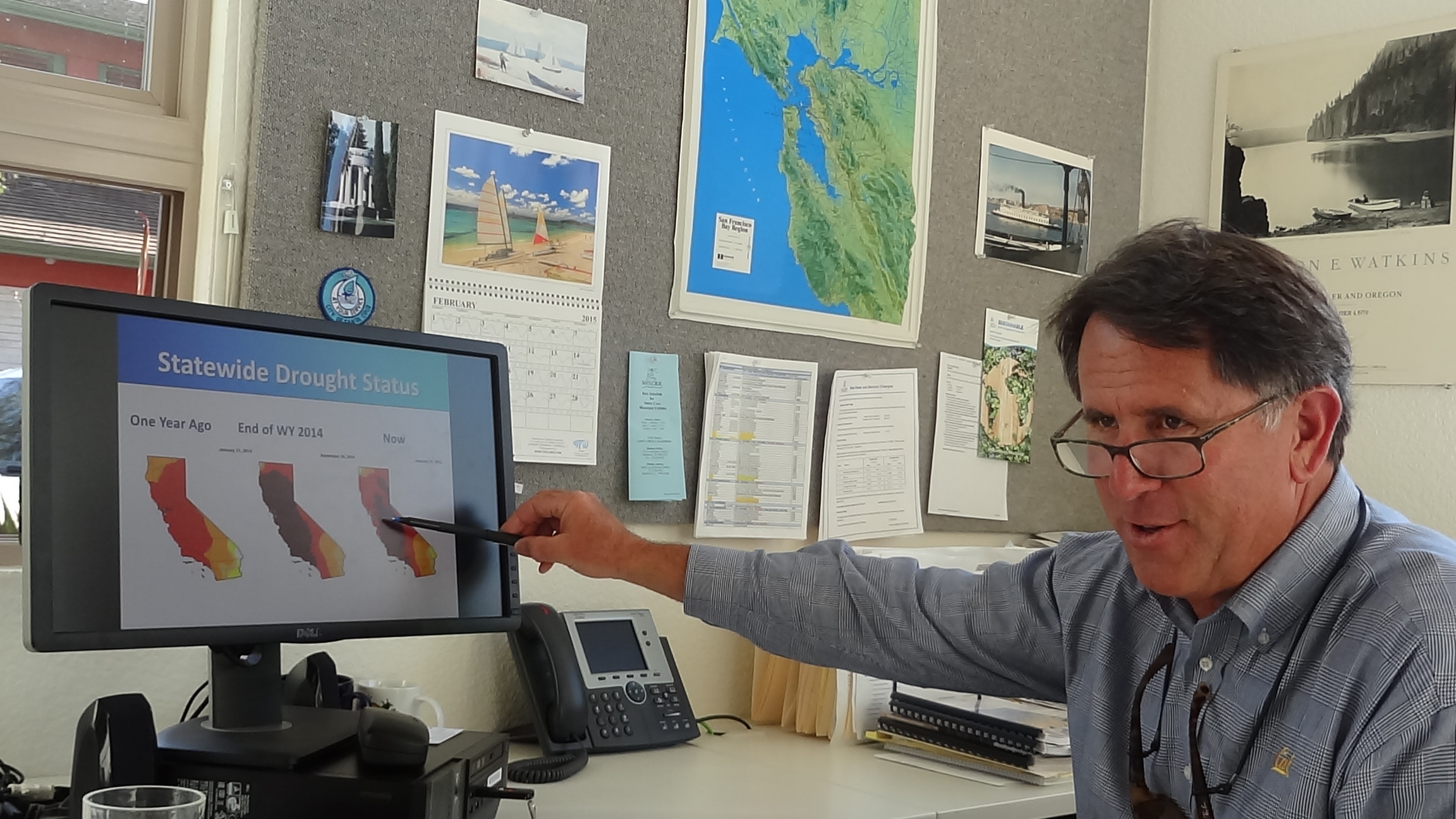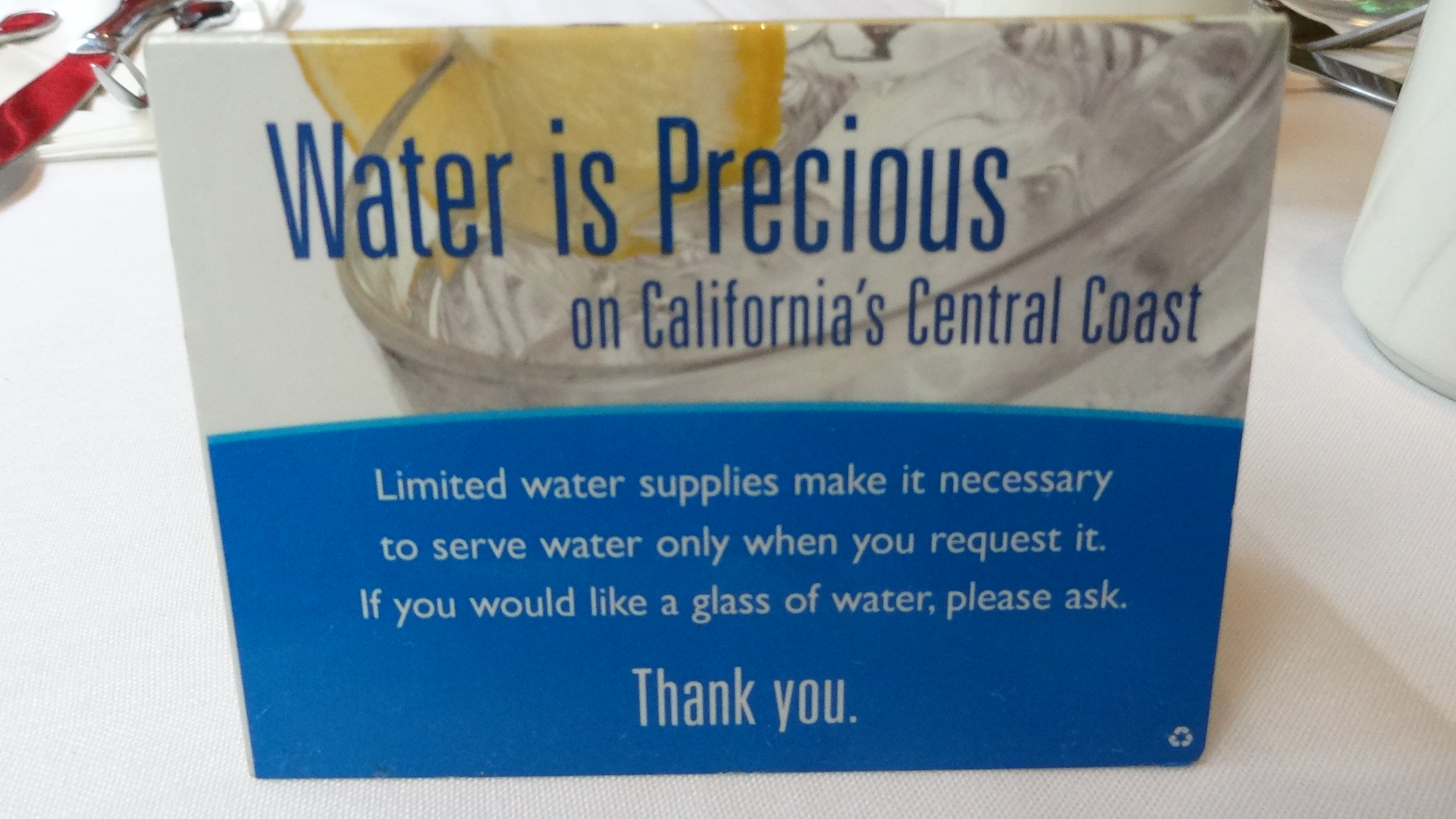As Drought Crisis Deepens, California Localities Face Tough Ongoing Water Reductions

California Gov. Jerry Brown answers questions concerning the proposed $1 billion package of emergency drought-relief legislation during a Capitol news conference in Sacramento, Calif., Thursday, March 19, 2015 Rich Pedroncelli / AP Photo
Connecting state and local government leaders
Santa Cruz can’t import water like many other Golden State cities. “We’re on our own,” water czar says.
SANTA CRUZ, Calif. — When the rains came in December in this arid beach town about 75 miles south of San Francisco, the only river and reservoir on the western slope of the Santa Cruz Mountains gained enough water to give citizens a welcome break. Water-use restrictions were lifted and life’s rhythms were restored.
Golfers were among those who rejoiced, in anticipation of playing again at the renowned PasaTiempo club, where the fairways had dried to a deep brown as its water allotments were cut by 30 percent.
Santa Cruz had the toughest water restrictions in the Golden State during last year’s severe drought conditions.
The rugged mountains, which separate the city from San Jose and Silicon Valley, have made it too difficult to import water from the north and east, so Santa Cruz is wholly reliant on local sources.
“We are on our own,” Toby Goddard, whose title as administrative services manager in the city’s Water Department does not suggest his power as Santa Cruz’s water czar, said in an interview.
Goddard imposed stiff fines for water violations and created a “water school” for scofflaws, among many other measures.
Drought conditions impact a number of Western states, but they’re especially severe in California. A dramatic headline in the Los Angeles Times last week—“California has about one year of water left”—created a lot of buzz.
Earlier this week, California’s State Water Resources Control Board adopted new regulations to further curtail water usage.
On Thursday, Gov. Jerry Brown announced the rapid deployment of $1 billion in drought-related spending.
The alarming L.A. Times op-ed was authored by Jay Famiglietti, senior water scientist at NASA’s Jet Propulsion Laboratory and a hydrology professor of Earth system science at the University of California at Irvine.
Famiglietti reported that NASA satellites show water available in the Sacramento and San Joaquin river basins was 34 million acre feet below normal—the equivalent of 1.5 times the capacity of Lake Mead, the nation’s largest reservoir.
Statewide, he reported, available water has been dropping by more than 12 million acre feet a year since 2011, accelerating a downward trend that began around the turn of the 21st century.
With severe cuts in surface water allocations, farmers in the Central Valley breadbasket have stepped up groundwater pumping, but, Famiglietti wrote, “wells are running dry” and in some areas “the land is sinking by one foot or more per year.”
The principal cause for concern going forward is the paucity of the Sierra Nevada snowpack, as The New York Times reported this week in an in-depth article about the California water crisis. In a March 3 exercise to measure the statewide snowpack, authorities found the equivalent of five inches, just 19 percent of the average for that date.
High temperatures have been a principal cause of the drought: Last year’s winter average of 45.6 degrees has been exceeded this year, with an average of 47.4 degrees. A string of 90-degree days in Los Angeles was the longest since recordkeeping began in 1977.
The heat destroyed a large bloom of poppies in the Antelope Valley, site of the California Poppy Reserve.
California’s important agricultural sector is suffering. Rice farmers in particular have been taking land out of production, in part because they are being offered a high price to sell their water allotments to the Metropolitan Water District of Southern California, which supplies vast amounts of water to Los Angeles and surrounding cities. The going price this year is $700 an acre foot, up from a seemingly exorbitant price of $500 the year before.
On Monday, the State Water Resources Control Board voted to strengthen emergency drought regulations already in place in many jurisdictions since the governor declared a water emergency in January 2014.
At the time, Brown said the state might be facing the worst drought in recorded history, and he urged Californians to reduce water use by 20 percent from 2013 levels.
The water board found a reduction of only 8.8 percent in January of this year, compared to the 2013 baseline. December rains in Santa Cruz and elsewhere had given way to an unusually hot and dry January, inducing people to open up hoses and sprinklers to water their landscaping.
The water board ordered urban agencies to limit outdoor watering to specific days of the week, perhaps two days a week in many places. All outdoor irrigation is banned within 48 hours of “measurable rainfall.”
Water agencies will also have to begin reporting how many warnings and fines they issue; failure to comply could bring $500-a-day fines for businesses or individuals. Doubtless the regulations will pinch in some areas, but they will “have little or no effect in most major Southern California cities, which already have watering restrictions,” according to a report in the L.A. Times.
The new rules also ban bars and restaurants from serving water unless by request, and order hoteliers to offer guests the option of not having towels and linens laundered daily.
Toby Goddard, administrative services manager in the city of Santa Cruz's Water Department, discusses the impacts of California's ongoing drought on his city. (Photo by Timothy B. Clark / GovExec.com)
Santa Cruz’s Draconian Measures
Cities that haven’t fully confronted the drought crisis may catch a glimpse of the future by studying what happened last year in Santa Cruz.
Without access to external sources of water, Goddard and his colleagues took many draconian steps. They were outlined in considerable detail in a presentation Goddard had made on Feb. 2 to the California Irrigation Institute.
As we sat in his office during a recent visit, he discussed the data included in his paper, titled “2014 Drought: We are Really in the Thick of It.”
Three years of drought have left Santa Cruz’s two main sources of water supply—the San Lorenzo River and the Loch Lomond Reservoir—far below normal levels. The river provides nearly half of supply. But in the year ending Oct. 1, 2014, cumulative runoff from the San Lorenzo was just 13,901 acre feet, down from a long term average of 95,000 acre feet.
The city declared water shortage alerts beginning in 2012. In February 2014, it declared a water shortage emergency, connoting shortages of 15 to 25 percent.
The Stage 3 emergency brought into effect water rationing for single-family and multi-family housing; mandatory water usage audits, conservation plans and irrigation restrictions for commercial customers of the local water agency, rationing for large irrigation accounts and outdoor water restrictions for all customers.
The goal was to cut water consumption by 20 percent below the dry season of 2012-13, and to conserve enough to have the reservoir at 45 percent of capacity by Oct. 31—enough to ensure adequate, if tight, supplies for 2015.
Goddard’s office mounted a public outreach plan that included direct mail, community events and revisions of utility bills. Billing frequency was increased to monthly, and bar charts compared monthly usage with water allotments and prior-year records.
Single-family homes were allotted 10 units of water per month, equivalent to 250 gallons a day, or enough to support a family of four. People with large households could apply for, and were granted, larger allotments. Grants to multi-family developments were calibrated by number of dwelling units. Large landscape accounts were allowed only one-third of normal water use.
And sizable penalties were announced for excess use: $45 to $50 for each added unit of water.
These allotments were sufficient to permit some landscape watering, but here too restrictions were tough: no watering between 10 a.m. and 5 p.m., required hose nozzles, no filling of swimming pools, a mandate to repair plumbing leaks within 24 hours, and fines of up to $500 after a warning. The city established a hotline for citizens to report water violations.
Goddard’s office hands out free shower heads, hose nozzles, faucet aerators, toilet-leak detection dye and other items to cut back home use. Rainwater barrels can be purchased at reduced price, and rebates are available up to $150 for high-efficiency toilets and $100 for water-efficient clothes washers.
People who abandoned their lawns can get awards of 50 cents per square foot of converted landscape, up to $500. Similar grants of up to $2,500 are available to businesses and multi-family housing.
The city received many applications for increased allocations, and granted more than 2,000 for large households and for health, safety, sanitation and fire protection.
Goddard also established a “water school,” where usage violators could eliminate their first-time fines, some in the hundreds of dollars, by attending a two-hour class on Monday evenings. About 700 citizens attended.
Goddard reported success. Residential use was down by 35 percent in single-family homes and 22 percent in multi-family dwellings on Oct. 31. Other categories reported similar results—with an overall reduction of 28 percent.
Loch Lomond was at 59 percent of capacity.
A sign at a local Santa Cruz restaurant underscores the severity of the water crisis. (Photo by Timothy B. Clark / GovExec.com)
Perhaps suffering most was the PasaTiempo golf course. The fairways went brown as maintenance people used their allotments to preserve greens and their surrounds.
In December, rains came to Santa Cruz. Rationing was suspended. But January saw no rain and by March 19 only 3 inches had fallen since the December deluge. No rain was in the forecast, and chances were slim that much would fall before the end of the “wet” season in mid-April.
And so, Goddard said on Wednesday, the rationing regime is being readied again.
Many California localities haven’t been waiting around to take action, either.
For instance, municipal leaders in Sacramento voted last month to order faster installation of water meters throughout the city. In November, city leaders in San Diego adopted a $3.5 billion plan to recycle wastewater for human consumption. And Santa Barbara is working to resuscitate a never-used desalination plant it built in the early 1900s.
With no long-term relief in sight, state and local leaders plus residents across the state are facing tough choices.
As California’s water crisis deepens, officials in these and other cities have much to learn from Santa Cruz’s experience as they struggle to deal with the long-running, increasingly severe drought.

NEXT STORY: How Colorado Is Getting Its State Employees to Lose Weight





